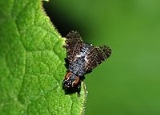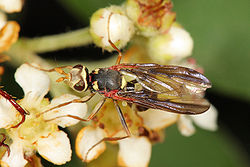
Platystomatidae
Encyclopedia
Platystomatidae is a distinctive family of flies (Diptera
). Signal flies are worldwide in distribution predominating in the tropics. It is one of the larger families of acalyptrate
Diptera with around 1200 species
in 119 genera
.
, and root nodules. Most larvae are either phytophagous (eating plant material) or saprophagous (eating decomposing organic matter). Some are predatory on other insects and others have been found in human lesions, while others are of minor agricultural significance.
 Signal flies are very variable in external appearance, ranging from small (2.5 mm), slender species to large (20 mm), robust individuals, often with body colours having a distinctive metallic lustre and with face and wings usually patterned with dark spots or bands.
Signal flies are very variable in external appearance, ranging from small (2.5 mm), slender species to large (20 mm), robust individuals, often with body colours having a distinctive metallic lustre and with face and wings usually patterned with dark spots or bands.
Many bizarre forms of morphology occur in this family. Heads and legs (fore legs especially) may be oddly shaped, extended in various ways or with adornments, all of which serve to supplement agonistic behaviour
. Such behaviour underlies social and sexual interaction between individuals of the same species of Signal flies, first researched in Australian species of the genera Euprosopia and Pogonortalis
In males of Pogonortalis, the length and degree of development of hairs (setae) on the lower facial area, together with widening of the head, facilitates territorial dominance by head-butting and rearing-up behaviours. Head-butting is taken to the extreme in the Australasian genus Achias , in which species have the fronto-orbital plates expanded laterally to produce eyes stalks.
Development of body structures is prevalent in the Afrotropical and Oriental subfamily Plastotephritinae , including 9 different types of modification in 16 genera .
Development of eye-stalks in flies is also prevalent in the family Diopsidae, through lateral development of the frontal plate, with the result that the antennae are situated on the extremity of the stalk near the compound eye. The process of development in Signal flies is different, however, in that the fronto-orbital plates expanded laterally to produce eyes stalks and consequently the antennae remain in the mid-line position. The development of eyestalks reaches its extreme in the species Achias rothschildi Austen, 1910 from New Guinea, in which males have an eye-span of up to 55 mm .
Families of acalyptrate
flies exhibiting morphological development associated with agonistic behaviour include:
Clusiidae
Diopsidae
Drosophilidae
Platystomatidae
Tephritidae
Ulidiidae.
See also http://delta-intkey.com/britin/dip/www/platysto.htm
Diptera
Diptera , or true flies, is the order of insects possessing only a single pair of wings on the mesothorax; the metathorax bears a pair of drumstick like structures called the halteres, the remnants of the hind wings. It is a large order, containing an estimated 240,000 species, although under half...
). Signal flies are worldwide in distribution predominating in the tropics. It is one of the larger families of acalyptrate
Acalyptratae
Acalyptratae is a subsection of Schizophora, commonly referred to as the acalyptrate muscoids . It is a very large assemblage, exhibiting very diverse habits, with one notable and perhaps surprising exception; there are no known acalyptrates that are obligate blood-feeders , though this is a life...
Diptera with around 1200 species
Species
In biology, a species is one of the basic units of biological classification and a taxonomic rank. A species is often defined as a group of organisms capable of interbreeding and producing fertile offspring. While in many cases this definition is adequate, more precise or differing measures are...
in 119 genera
Genus
In biology, a genus is a low-level taxonomic rank used in the biological classification of living and fossil organisms, which is an example of definition by genus and differentia...
.
Biology
Adults are found on tree trunks and foliage and are attracted to flowers, decaying fruit, excrement, sweat, and decomposing snails. Larvae are found on fresh and in decaying vegetation, carrion, human corpsesForensic entomology
Forensic entomology is the application and study of insect and other arthropod biology to criminal matters. It is primarily associated with death investigations; however, it may also be used to detect drugs and poisons, determine the location of an incident, and find the presence and time of the...
, and root nodules. Most larvae are either phytophagous (eating plant material) or saprophagous (eating decomposing organic matter). Some are predatory on other insects and others have been found in human lesions, while others are of minor agricultural significance.
Family Description

Many bizarre forms of morphology occur in this family. Heads and legs (fore legs especially) may be oddly shaped, extended in various ways or with adornments, all of which serve to supplement agonistic behaviour
Agonistic behaviour
In ethology, agonistic behaviour is any social behaviour related to fighting. Thus it is broader than aggressive behaviour because it includes not only actual aggression but also threats, displays, retreats, placating aggressors, and conciliation. The term was coined by Scott and Fredericson in 1951...
. Such behaviour underlies social and sexual interaction between individuals of the same species of Signal flies, first researched in Australian species of the genera Euprosopia and Pogonortalis
In males of Pogonortalis, the length and degree of development of hairs (setae) on the lower facial area, together with widening of the head, facilitates territorial dominance by head-butting and rearing-up behaviours. Head-butting is taken to the extreme in the Australasian genus Achias , in which species have the fronto-orbital plates expanded laterally to produce eyes stalks.
Development of body structures is prevalent in the Afrotropical and Oriental subfamily Plastotephritinae , including 9 different types of modification in 16 genera .
Development of eye-stalks in flies is also prevalent in the family Diopsidae, through lateral development of the frontal plate, with the result that the antennae are situated on the extremity of the stalk near the compound eye. The process of development in Signal flies is different, however, in that the fronto-orbital plates expanded laterally to produce eyes stalks and consequently the antennae remain in the mid-line position. The development of eyestalks reaches its extreme in the species Achias rothschildi Austen, 1910 from New Guinea, in which males have an eye-span of up to 55 mm .
Families of acalyptrate
Acalyptratae
Acalyptratae is a subsection of Schizophora, commonly referred to as the acalyptrate muscoids . It is a very large assemblage, exhibiting very diverse habits, with one notable and perhaps surprising exception; there are no known acalyptrates that are obligate blood-feeders , though this is a life...
flies exhibiting morphological development associated with agonistic behaviour include:
Clusiidae
Clusiidae
Clusiidae or "druid flies" is a family of small , thin, yellow to black acalyptrate flies with a characteristic antenna and with the wing usually partially infuscated. The larvae are notable for their ability to jump. Males of many species in the subfamily Clusiodinae have been observed while...
Diopsidae
Drosophilidae
Drosophilidae
Drosophilidae is a diverse, cosmopolitan family of flies, which includes fruit flies. Another family of flies called Tephritidae also includes fruit flies. The best known species of Drosophilidae is Drosophila melanogaster, within the genus Drosophila, and this species Is used extensively for...
Platystomatidae
Tephritidae
Tephritidae
Tephritidae is one of two fly families referred to as "fruit flies", the other family being Drosophilidae. Tephritidae does not include the biological model organisms of the genus Drosophila , which is often called the "common fruit fly". There are nearly 5,000 described species of tephritid...
Ulidiidae.
See also http://delta-intkey.com/britin/dip/www/platysto.htm

